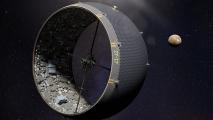
The New Space Race
Reusable rockets are real, the internet is in orbit, and we’re heading to Mars. With space manufacturing, asteroid mining, and lunar bases, the new space race has just begun, transforming life on Earth forever.
Read More
Undergrad develops AI to hunt for alien signals
An AI trained to hunt for technosignatures from intelligent alien life found 8 interesting signals on its first deployment.
Could hydrogen-fuelled flights be a reality by 2035?
By 2035, hydrogen fuel cells could be used to electrify mid-range flights and hydrogen combustion aircraft could be used on long-haul flights.
NASA’s “Lucy” will take a 40,000-mile detour to visit this asteroid
NASA has added a tenth asteroid flyby to the record-breaking Lucy mission so that it can test a new asteroid-tracking system.
This near-Earth asteroid is 4.2 billion years old and nearly indestructible
By analyzing just three dust particles, researchers learned that the rubble pile asteroid Itokawa is 4.2 billion years old and hard to kill.
Rare Martian meteorite is full of complex carbon molecules
A 650-million-years-old meteorite found in Africa shows the rich and complex chemistry that once happened on Mars.
Cosmic dust from Venus is inspiring new air pollution-busting technology
Inspired by chemistry observed on the surface of Venus, researchers produced a synthetic material that could improve air quality.
Jupiter’s hot “pizza moon” may contain life
Jupiter’s moon Io is thought to be inhospitable, but new data suggests life could exist underground, perhaps in lava tubes.
Startup’s bladeless flying car is designed to reach Mach 0.8
Jetoptera is designing quieter, safer vertical take-off and landing (VTOL) vehicles with bladeless propulsion systems.
NASA announces alien-hunting Habitable Worlds Observatory
NASA has announced that it is developing the Habitable Worlds Observatory, a new space telescope optimized to hunt for extraterrestrial life.
World’s largest plane sets new flight record
A new test flight puts the world’s largest plane one step closer to helping the US develop — and respond to — hypersonic weapons.
How to prove Einstein’s relativity for under $100
Muons only live for 2.2 microseconds before decaying. Thanks to Einstein’s relativity, they make it to the surface of the earth. Here’s how to prove it.
SpaceX puts Starlink promises to astronomers in writing
SpaceX has signed an agreement with the National Science Foundation detailing its plans to minimize Starlink’s impact on astronomy.
Scientists use laser beam to divert lightning strikes
Since the time of Benjamin Franklin, we’ve looked for ways to control, or at least deflect, lightning strikes. Enter laser-guided lightning.
The case for dark matter has strengthened
Though it makes up about 26% of the Universe, we cannot see dark matter. But we know it’s there because we can see its effects.
What happens when an astrophysicist puts ChatGPT to the test?
Can an astrophysicist get ChatGPT to learn and assimilate new information and give correct answers where it gave confident but false ones?
This Swedish start-up is building an electric airliner
A Swedish startup has joined the race to build the world’s first electric airplane to help reduce the carbon impact of flying.
NASA and ESA are racing to bring GPS to the moon
Two upcoming space missions by NASA and ESA could help bring satellite navigation (satnav) to the moon and cislunar space.
Ring galaxies, the rarest in the Universe, finally explained
After decades of wondering how ring galaxies form, we’ve caught them in enough stages of evolution that we finally know where they come from.
A far-out plan to build an asteroid city
University of Rochester researchers think they have a solution to creating an asteroid city: a giant bag.
China’s new space station is open for business
On Nov. 29, 2022, the Shenzhou 15 mission launched from China’s Gobi Desert carrying three taikonauts – the Chinese word for astronauts.
Subscribe to the newsletter





















